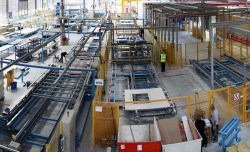We can all be seduced by the proposition of advanced building systems. For some the vision of factory-manufactured building solutions, where completed elements glide along robot-controlled production assembly lines and are transported effortlessly to site - devoid of all the angst and quality issues associated with traditional building - is the panacea for construction.
Most of us, faced with the normal vagaries of the construction site find this particularly appealing, with a vision of perfect control over the weather, deliveries, materials, labour and the availability of skills.
Manufacturing facilities can provide the sort of environment that the average construction site can only dream of. The use of Design for Manufacture and Assembly (DfMA) approaches supported by modern lean manufacturing processes means that operatives can achieve repeat procedures that are accurate and fault free. In the more advanced manufacturing facilities this is translated into semi-automated assembly production processes where the operator is assisted by mechanisation that further enhances the quality of output. This machinery can be computer-controlled to record set-up data, detail work instructions specific to the task and traceability information that can be used to identify faulty components or materials in the event of a latent defect issue or premature failure.
Digital transformation is happening all around us and whilst other industries have been quick to make the digital leap, the construction industry has been a little slower out of the starting blocks but now the revolution is well underway. Smart technology is changing the face of construction with a range of devices making complicated tasks much easier - from virtual reality to smart helmets and digital software efficiencies. The combination of offsite manufacturing and digital construction technology presents a compelling proposition and the rate of technological advancements is accelerating at such a relentless pace, it cannot be ignored.
Building Information Modelling (BIM) has been the subject of much debate but the software offers so much more than the creation of 3D models. Virtual Reality - an artificial, computer-generated simulation of an environment - has transformed the way that architects present their vision. It immerses the user by making them feel like they are experiencing the simulated reality first hand - allowing clients to play an integral part of the design process and 'virtually' enter the building and validate the layout. Augmented Reality on the other hand, provides more freedom for the user because it does not need to be a head-mounted display. Augmented Reality takes the real world and adds something to it - digitally superimposing buildings on to live sites.
For certain we will see the building technology supply base continuing to grow to meet the quite incredible demand for these offsite manufactured building methods. Companies will continue to invest in sophisticated manufacturing plant and advanced quality management systems that are essential to deliver 21st century standards of product performance.
The future of construction is in the factory and it is bright. There is no reason why the visions that are regularly portrayed in the automotive sector should not become commonplace in the building sector. Robot manufacture of complete building elements is a plausible reality where the human interface is limited to material input and product take-off. The quality in this production environment should be exemplary and make zero defects a real possibility.
Author Darren Richards Managing Director of Cogent Consulting









